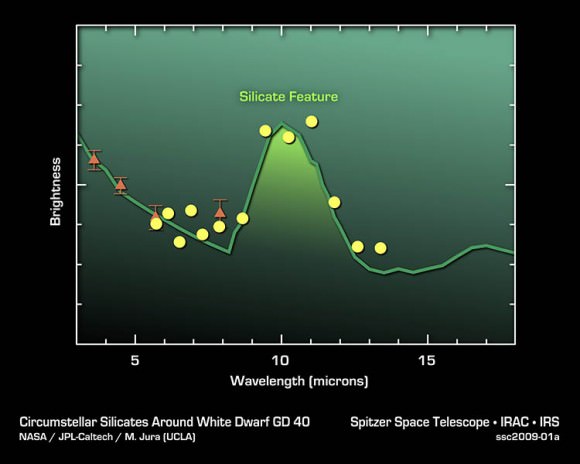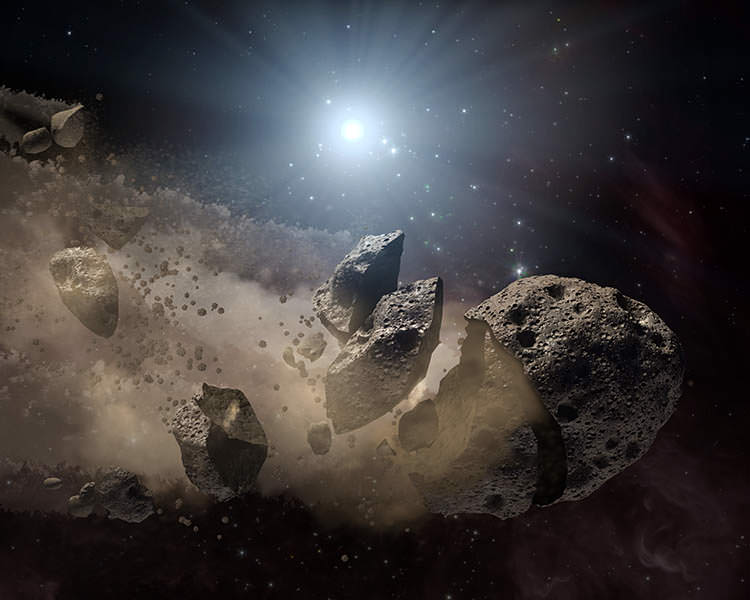[/caption]
Astronomers studying white dwarfs have found the remains of “shredded” asteroids around some of these dead stars. This finding suggests that the same materials that make up Earth and our solar system’s other rocky bodies could be common in the universe. If the materials are common, then rocky planets could be, too. “If you ground up our asteroids and rocky planets, you would get the same type of dust we are seeing in these star systems,” said Michael Jura of the University of California, Los Angeles, who presented the results today at the American Astronomical Society meeting in Long Beach, Calif. “This tells us that the stars have asteroids like ours — and therefore could also have rocky planets.” But most surprising, astronomers have been able to use the rocky debris to study the evolution of planets.
Observations with NASA’s Spitzer Space Telescope reveal six dead “white dwarf” stars littered with the remains of shredded asteroids.
Asteroids and planets form out of dusty material that swirls around young stars. The dust sticks together, forming clumps and eventually full-grown planets. Asteroids are the leftover debris. When a star like our sun nears the end of its life, it puffs up into a red giant that consumes its innermost planets, while jostling the orbits of remaining asteroids and outer planets. As the star continues to die, it blows off its outer layers and shrinks down into a skeleton of its former self — a white dwarf.
Sometimes, a jostled asteroid wanders too close to a white dwarf and meets its demise — the gravity of the white dwarf shreds the asteroid to pieces. A similar thing happened to Comet Shoemaker Levy 9 when Jupiter’s gravity tore it up, before the comet ultimately smashed into the planet in 1994.
Spitzer observed shredded asteroid pieces around white dwarfs with its infrared spectrograph, an instrument that breaks light apart into a rainbow of wavelengths, revealing imprints of chemicals.

“While no one yet has the ability to directly see the smashed up debris and measure its composition, we have the tools to measure the potential capacity for planets,” said Jura at today’s press conference.
Spitzer analyzed the asteroid dust around two so-called polluted white dwarfs; the new observations bring the total to eight. Jura said only 1% of white dwarfs observed have broken up asteroids in their vicinity.
“Now, we’ve got a bigger sample of these polluted white dwarfs, so we know these types of events are not extremely rare,” said Jura.
In all eight systems observed, Spitzer found that the dust contains a glassy silicate mineral similar to olivine and commonly found on Earth. “This is one clue that the rocky material around these stars has evolved very much like our own,” said Jura.
The Spitzer data also suggest there is no carbon in the rocky debris — again like the asteroids and rocky planets in our solar system, which have relatively little carbon.
A single asteroid is thought to have broken apart within the last million years or so in each of the eight white-dwarf systems. The biggest of the bunch was once about 200 kilometers (124 miles) in diameter, a bit larger than Los Angeles County.
Jura says the real power of observing these white dwarf systems is still to come. When an asteroid “bites the dust” around a dead star, it breaks into very tiny pieces. Asteroid dust around living stars, by contrast, is made of larger particles. By continuing to use spectrographs to analyze the visible light from this fine dust, astronomers will be able to see exquisite details — including information about what elements are present and in what abundance. This will reveal much more about how other star systems sort and process their planetary materials.
“It’s as if the white dwarfs separate the dust apart for us,” said Jura.
Source: Spitzer Space Telescope, AAS Press Conference


It is probably full of life out there too.
So, it sounds as if the data is not in yet. And how exactly can they tell us if it was a system that was incinerated by and expanding star at its final demise. And that all that was left from the explosion was debris that looked like asteroids.
Salacious — “Please define ‘. . . a bit larger than Los Angeles County’. Is Los Angeles all of Los Angeles or a part of it.” Notice that it says in the article: “A single asteroid is thought to have broken apart within the last million years or so in each of the eight white-dwarf systems. The biggest of the bunch was once about 200 kilometers (124 miles) in diameter, a bit larger than Los Angeles County.” The salient point is the former size of the asteroid, ~ 200 km/124 miles in diameter, and that’s given. But if you insist, Los Angeles, the city, is only part of Los Angeles, the county, which is part of coastal Southern California. I highly recommend a good Rand-McNally map of the area, or one online. L.A. County itself is a little less than 125 km across. As for the broken-up asteroids around *observed* white dwarves, the evidence is part of the observations. More, the dust and bits of rock that are seen must have come from far larger conglomerates, i.e., asteroids or even chunks of rocky planets, because you don’t get dust of that composition that hasn’t once been part of a rocky conglomerate. This is known from geochemistry.
Please define “….a bit larger than Los Angeles County”. Is Los Angeles County all of Los Angeles or a part of it. For the rest of us insignificant non-U.S. readers.
Also the statement;
“Jura said only 1% of white dwarfs observed have broken up asteroids in their vicinity.”
Based on what evidence? Surely this is an assumption and speculation, with little observational evidence to support it? We don’t know very much of the composition of material around normal stars, so how can we discuss the outcomes at the end of a star’s without knowing the accretion process.
Also GD 40 is also one white dwarf out of billions and billions of them.
that’s the metric system … time to adjust that Drake equation … love you’re work and you’re product..
Now I am totally confused. If Los Angeles county is less than 125 km across, why say it is “a bit larger than 200km”? Wiki says “Los Angeles County borders 70 miles (110 km) of coast on the Pacific Ocean.” – an area, including land and water.
Even wiki says first off; “The Greater Los Angeles Area, or the Southland, (not to be confused with the Los Angeles Metro Area which includes only Los Angeles and Orange Counties.)”
According to wiki, even The Greater Los Angeles Area is 4, 500 square miles (12,581 sq. km.) , meaning the area has the mean diameter only about 67 km (112 km}.
Logically I think, it would have been so much better to say the objects were he diameter equivalent to the distance between Los Angeles and San Diego, which is roughly 209 km (130 miles)? Perhaps even the diameter of minor planet No.6, Hebe or No.7 Iris would also be appropriate?
At least this gives some impression that can be understood by anyone. Being non-American, and never visiting the U.S. (find being fingerprinted, biometric data testing totally abhorrent -especially when they a not destroyed when you leave – but that’s another matter) – anyway well perhaps you can see my point.
Regardless, thanks for the information.
Salacious
Just go with the measurement in kilometers, and don’t worry about the additional description. If you can’t figure that much out… then you aren’t going to be able to handle anything more complicated.
…the greater LA area has more than one county… obviously, since the size given (for the area) is much larger than the 200km figure. Simple algebra and common sense.
Let’s get this right…
Article statement
“The biggest of the bunch was once about 200 kilometers (124 miles) in diameter, a bit larger than Los Angeles County.”
Definition of “Los Angeles County”, one of five counties in the Greater Los Angeles Area.
Area of Los Angeles County is 4,752 sq.mi (12,308 km^2), Therefore this County covers a mean size of about 69 miles or 110.9km. If 110.9 km is about half 200 km. Ergo,the statement that it is “a bit larger than Los Angeles County” is factually incorrect.
i agree. the text should be either removed or changed into something like “almost twice as large as Los Angeles County”
Come on folks. The presumed measurement of the arteroid is given with the number “about 200 kilometers”. The bit about LA County was just to provide some perspective. It is no different than itty-bitty-thing scientists talking about the size of an object in relation to a human hair. Again, that gives perspective to laymen. If you are inclined to get all wrapped around the axle on this LA thing, go to the article, do a Ctrl-A, then Ctrl-C, open a word processor of your choice, then do a Cnrl-V. Find the offending ‘measurement’. Highlight it and then hit the delete key. Perhaps then it will be a less confusing article for you. As for the adults who are reading the article, I suspect you can read it unmodified.
Lol. I live in LA, and I’d love to contribute to this debate about the size of this little Californian town… but I can’t. But I did attend the press conference on this article and it was awesome! Also, there is shedloads of work going into the whole shredded asteroid thing around white dwarfs. Awesome article Nancy!
But look out, I have a UT exclusive on the horizon, using this kind of research for something quite profound. Watch this space….
Cheers, Ian